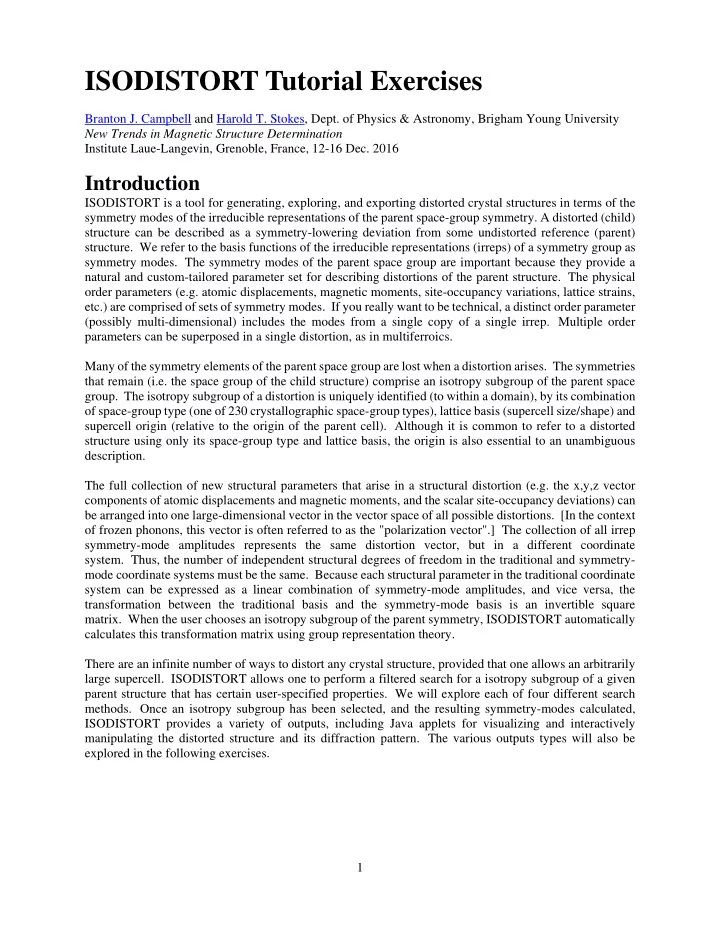

ISODISTORT Tutorial Exercises Branton J. Campbell and Harold T. Stokes, Dept. of Physics & Astronomy, Brigham Young University New Trends in Magnetic Structure Determination Institute Laue-Langevin, Grenoble, France, 12-16 Dec. 2016 Introduction ISODISTORT is a tool for generating, exploring, and exporting distorted crystal structures in terms of the symmetry modes of the irreducible representations of the parent space-group symmetry. A distorted (child) structure can be described as a symmetry-lowering deviation from some undistorted reference (parent) structure. We refer to the basis functions of the irreducible representations (irreps) of a symmetry group as symmetry modes. The symmetry modes of the parent space group are important because they provide a natural and custom-tailored parameter set for describing distortions of the parent structure. The physical order parameters (e.g. atomic displacements, magnetic moments, site-occupancy variations, lattice strains, etc.) are comprised of sets of symmetry modes. If you really want to be technical, a distinct order parameter (possibly multi-dimensional) includes the modes from a single copy of a single irrep. Multiple order parameters can be superposed in a single distortion, as in multiferroics. Many of the symmetry elements of the parent space group are lost when a distortion arises. The symmetries that remain (i.e. the space group of the child structure) comprise an isotropy subgroup of the parent space group. The isotropy subgroup of a distortion is uniquely identified (to within a domain), by its combination of space-group type (one of 230 crystallographic space-group types), lattice basis (supercell size/shape) and supercell origin (relative to the origin of the parent cell). Although it is common to refer to a distorted structure using only its space-group type and lattice basis, the origin is also essential to an unambiguous description. The full collection of new structural parameters that arise in a structural distortion (e.g. the x,y,z vector components of atomic displacements and magnetic moments, and the scalar site-occupancy deviations) can be arranged into one large-dimensional vector in the vector space of all possible distortions. [In the context of frozen phonons, this vector is often referred to as the "polarization vector".] The collection of all irrep symmetry-mode amplitudes represents the same distortion vector, but in a different coordinate system. Thus, the number of independent structural degrees of freedom in the traditional and symmetry- mode coordinate systems must be the same. Because each structural parameter in the traditional coordinate system can be expressed as a linear combination of symmetry-mode amplitudes, and vice versa, the transformation between the traditional basis and the symmetry-mode basis is an invertible square matrix. When the user chooses an isotropy subgroup of the parent symmetry, ISODISTORT automatically calculates this transformation matrix using group representation theory. There are an infinite number of ways to distort any crystal structure, provided that one allows an arbitrarily large supercell. ISODISTORT allows one to perform a filtered search for a isotropy subgroup of a given parent structure that has certain user-specified properties. We will explore each of four different search methods. Once an isotropy subgroup has been selected, and the resulting symmetry-modes calculated, ISODISTORT provides a variety of outputs, including Java applets for visualizing and interactively manipulating the distorted structure and its diffraction pattern. The various outputs types will also be explored in the following exercises. 1
Preparation Download the tutorial files (get link from the presenter). Set your browser up so that new pages open in separate tabs of the same wdow rather than separate windows. Double-click on each of the *visual.html files in the “visualization” directory to visually explore a variety of order-parameter types. Make sure that you have a recent version of the Java run-time environment on your computer, which can either be installed manually from http://java.com/en/download/ or automatically from within the Java Console (in Utilities folder in MacOSX, or in Control Panel -> Programs in Windows). For Linux, see http://www.java.com/en/download/help/enable_console_linux.xml. Regardless of the platform or the installation method, we recommend that you DON'T install any 3 rd party helper tools (such as the "Ask Toolbar") that are sometimes packaged with Java by default -- you may actually have to uncheck a box to avoid them! If you don't see a nice interactive crystal structure, then your Java installation has problems. Try one or more of the following solutions: (1) Use the "Update" tab in your Java Console to update your java installation. (2) Use the "Java" tab in your Java Console to ensure that you have only one version of Java installed. (3) Use the "Security" tab in your Java Console to reduce the security settings to the lowest available level when using the applet. (4) If an error message appears in place of the applet within your browser window, try left or right clicking the error message for more information. You can also use the "Advanced" tab in the Java Console to "Show console", which sometimes gives more information about Java errors. (5) Always restart your browser after making a change in the Java Console. (6) Try more than one browser – note that Chrome will not work with Java applets. If you see the interactive applet, but some of the controls are only partially visible, the problem may not be the installation. Here are a few troubleshooting options: (1) Reset the browser magnification to the standard setting. In most browsers, pressing "Control 0" will accomplish this. (2) Try resetting your computer's display resolution to the recommended setting if you have changed it recently. (3) Use the "Java" tab on your Java Console to add "-Dsun.java2d.d3d=false" (without the quotes) as a run-time parameter; and always restart your browser after making a change in the Java Console. (5) Try your luck with a different browser (e.g. Firefox, IE, Safari, Opera). Go to the home page of the ISOTROPY Suite at http://iso.byu.edu, and follow the link to the home page of ISODISTORT. 2
Recommend
More recommend